Volatile Organic Compounds – Water & Air Treatment
Volatile organic compounds are a common source of pollution and pose hazards to human health when left untreated in the environment. H2K Technologies’ broad product line has VOC treatment options for water & air. Individual products and turnkey treatment systems are available for removal of hazardous VOCs.
Volatile organic compounds (VOCs) are carbon compounds which are easily released into air and are capable of evaporation under typical conditions. VOCs occur naturally in the environment and also from human activities. The most common sources of manmade VOCs are industrial solvents and fossil fuels. Household products are a common source of volatile organic compounds including paints, cleaners, gasoline & diesel fuel, craft products, and glues, but these are low-impact on an individual scale.
VOC treatment is required for large-scale release of volatile organic compounds. Typical VOC treatment projects include underground tank leaks, dry cleaning remediation, and other industrial processes. Many compounds released from these processes can be hazardous to human health and cause long-term health effects. Volatile organic compounds can take a long time to degrade with some capable of traveling long distances in groundwater. Site cleanup and VOC treatment is critical to remove hazardous compounds from groundwater before they reach public and private wells.
Common volatile organic compounds include:
- Chlorinated Solvents – Trichloroethene, Tetrachloroethene, Vinyl Chloride, Chloroform, Dichloroethene (cis & trans), Trichloroethane
- Aromatic Hydrocarbons – Benzene, Toluene, Ethylbenzene, Xylenes (p-, o-, & m-), Phenol
- Polycyclic Aromatic Hydrocarbons (PAH) – Naphthalene, Pyrene, Anthracene
- Alkanes – Methane, Ethane, Propane, Butane, Pentane, Hexane and related isomers
- Ketones – Acetone, Methyl-Ethyl Ketone (MEK),
H2K Technologies offers a broad line of water treatment and vapor treatment products for VOC removal in industrial wastewater, agricultural, remediation, and other applications. Treatment equipment is offered as individual equipment and as part of an integrated turnkey system. VOC treatment technologies we offer include the following:
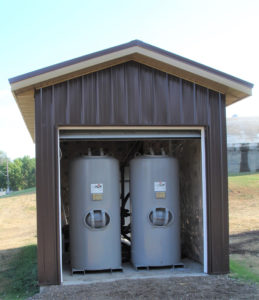
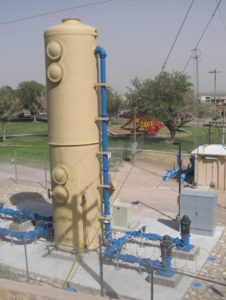
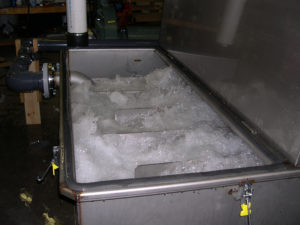
Air Strippers remove volatile organics from water by feeding a high volume of air through a volume of water. This forced draft aeration transfers VOCs from water to air for further treatment or discharge to ambient air. The effectiveness of air stripping varies for different compounds and is determined by the Henry’s constant of that compound. Air stripping is most effective for water treatment of chlorinated compounds and gasoline range organics. H2K Technologies offers several types of air stripper for different environments, click the link below for more information about our air stripper products.
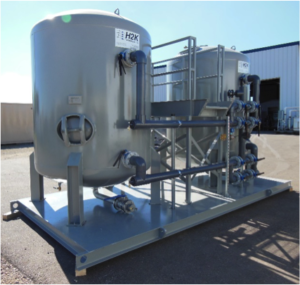
Liquid Phase Carbon provides VOC water treatment by capturing organic compounds on the surface of activated carbon media. This specialty media is very porous with a large surface area for adsorption of volatile organics. Carbon filtration provides effective treatment for a broad range of VOCs and is the most effective option for diesel range organics, PCBs, and pesticides. Activated carbon provides complete VOC removal while capacity is available on the media surface. Carbon has a finite lifespan and requires media changeout once capacity has been consumed and VOC breakthrough begins. Additional information about our liquid phase carbon equipment can be found at the link below:
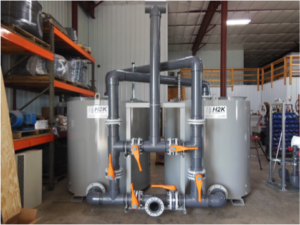
Vapor Phase Carbon is designed for volatile organic removal from air and other gases. Overall design is similar to the liquid phase companion, but with sizing and shape optimized for VOC capture from air. Vapor phase carbon is commonly used for removal of volatile organics in soil vapor extraction, air stripper discharge, and industrial offgas projects. Carbon capacity is finite, so this approach is typically used for lower VOC concentrations. Media lifespan is determined by quantity and shape of removed particles, and larger organic compounds will consume carbon capacity more quickly. Additional vapor phase carbon information can be found at the following link:
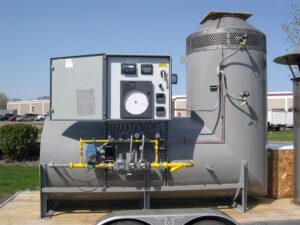
Thermal & Catalytic Oxidizers are used for vapor phase VOC treatment. Oxidizers are designed to completely destruct volatile organics through a high temperature reaction. This approach is best suited for high VOC concentrations where carbon would be consumed very quickly. Temperatures in an oxidizer are very high, but proper insulation and flame arrestors provide safe operation and VOC destruction without affecting other treatment and process equipment. Reference the cutsheets below for more information on the oxidizers we offer.
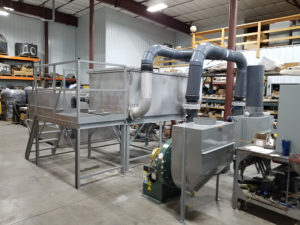
Packaged Treatment Systems are available when multiple treatment technologies are required. Volatile organic treatment systems often require pre-treatment of other contaminants to maximize VOC removal. Oil & grease, suspended solids, dissolved solids, and BOD/COD concerns will affect VOC treatment equipment and must be handled appropriately. H2K Technologies’ full product line also includes oil/water separators, clarifiers, sand filters, and other equipment to provide a complete water treatment package. Our turnkey treatment systems include UL-listed controls, installation, piping, and wiring to provide easy drop-in site installation. Additional information can be found at the link below.
